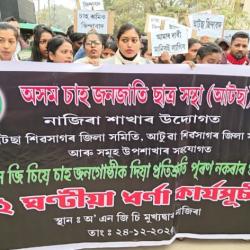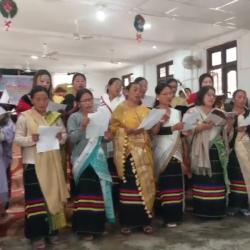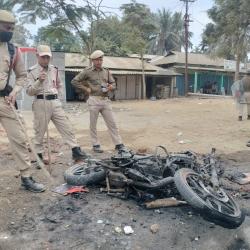Meet on transboundary conservation
For the 10th time since 2008,important delegatesrepresentingthe Governments of Bhutan and Indiaalong with conservation NGOs of the region met in Guwahati, Assam.The landmark meeting was held on 21st-22nd June 2016 to discuss Conservation of Biodiversity- Issues and Opportunities in the large Transboundary Landscape between India and Bhutan across the International Boundary from the river Sankoshinthe west to the River Dhansiri in the east, referred to as the TransboundaryManas Conservation Area (TraMCA). In India, it includes the Manas Tiger Reserveandin Bhutan, the forested areas of south covering the Royal Manas National Park, Phipsoo Wildlife Sanctuary and Jomotshangkha Wildlife Sanctuary. The Ecosystem Services provided by TraMCAsupports a total human population of over 10 million overIndia and Bhutan.
This meeting hadthe delegates taking stock of the status of implementation of the work plan developed for the region and also discussing aboutthe emerging issues specially with reference toproposed developmental activitieshaving potential negative impact and continued anthropogenic pressure on the forest resources. The delegates expressed their concerns on ongoing deforestation activities in the TraMCAlandscape and expressed the need for scaled up governmentefforts to arrest deforestation on an urgent basis. Restoration of the denudated forest areas and their protection was also discussed as the only possibility of regaining lost habitats. It is worth mentioning here that Manas Tiger Reserve has already lost about 40% of its forest cover to encroachments and development activities, since it was declared a Tiger Reserve in 1973. Mr. D.P. Bankhwal, IG Forest, National Tiger Conservation Authority (NTCA), Guwahati says, “Ecosystems are like Humpty Dumpty. If the balance is lost, it is lost forever. No amount of riches or power can bring it back.”
The meeting was also addressed by Mr. D. Mathur,PCCF & HOFF, Assam, who appreciated the effort of the Indian and Bhutanese in bringing the group together which is now well recognized internationally. He has also assured all support to see its progress further. A Swargowari, CHD, Forest Department of Bodoland Territorial Council expressed that the TraMCAconcept that gained momentum during the last six years is moving in right direction due to the effort of all the stakeholders.
The delegation from Bhutan, lead by TenzinWangchuk, Park Manager, Royal Manas National Park has expressed concerns with current and proposed developments in the landscape and emphasised on further strengthening the collaboration of the TraMCApartners to achieve its long term goals.
In the meeting, a report on joint monitoring of tigers was also released by Mr Mathur. The report presents the finding of joint monitoring of tigers in both Manas National Park, India and Royal Manas National Park, Bhutan. The study identified 21 individual tigers in the study area that covered approx. 600 sq km of India and Bhutan Manas in TraMCA. The study also found four individual tigers that are common to Bhutan and India Manas, indicating that the connectivity is crucial in the TraMCAregion to protect tiger as well as other biodiversity of the area. A previous study in the TraMCA in 2011-12 reported 14 individual tigers. The study was carried out during February-May 2015 simultaneously in India and Bhutan across the boundary by Forest officials and researchers from Aaranyak and WWF.
No facet of conservation in TraMCAwas left behind in this discussion which included delegates from agencies ranging from tourism, wildlife conservationists and biologists to government agencies. The following are a few salient discussion points of the meeting.
Conservation:
Tiger Conservation as an umbrella for accentuating the overall conservation status of the area was discussed. Besides discussing Tiger Protection, extensive discussions about Elephant conservation, Leopard and Ungulate species Monitoring, restoration of habitats, Control of invasive species. Besides, the idea of jointly monitoring Elephants by Radio Collaring was seen to gain great support from delegates of both India and Bhutan.
A variety of issues ranging from habitat loss, unregulated tourism, water unavailability, wildlife causalities, etc. were discussed in the meeting. However, a recent proposal by the Indian Government to have a highway constructed along the Indo-Bhutan International Border was discussed in most detail. The grave implications that such a linear structure may have on the fragile ecological balance of the area were discussed. Such developmental activities would bifurcate the contiguous habitats and adversely affect wildlife, which in turn will bring in severe ecological affects including water availability and agriculture regimes of the TraMCA region.
Other Contents by Author
The Golden langur (Trachypithecus geei) has now been listed in the World’s 25 Most Endangered Primates! It has been placed in this list due to extensive habitat fragmentation, habitat destruction and encroachment along its distribution range which has led to rapid population decline.This was declared in a sessionunder chairmanship of Dr. Russell A. Mittermeier (Chair,International Union for Conservation of Natures Species Survival Commission Primate specialist Group (IUCN,SSC, PSG) in the joint congress of International Primatological Society and American Society of Primatologist which was held at Chicago, USA from 21st to 27th August 2016. Dr. Dilip Chetry, Head of Primate Research and...
Precious one-horned rhino is facing unprecedented threat to its existence, with as many as 49 Rhinos already dead in 2016 itself. State Forest Minister, Pramila Rani Brahma, had recently revealed these shocking numbers in a statement. According to the official records, 22 rhinos had dies in natural calamity like the recent floods while the rest were butchered by poachers. Assam based Aaranyak, which had been working for the past 2 decades for rhino conservation in the state have submitted a set of recommendations for protection of rhinos and to urgently curb the growing cases of poaching of the species in the state. These were submitted at a workshop titled “NATIONAL LEVEL EXPERT...
Sunday is the World Environment Day and this year’s global theme “Zero tolerance for Illegal Wildlife Trade” found resonance in events observed across Assam, to mark the day.New recruits of Assam Police joined hands to learn about nature, to care for the environment and environmental issues through an awareness event organised by Aaranyak in collaboration with Assam chapter of Institutions of Engineers and 4th APBN authorities in Guwahati.A big number of recruits under training at 4th APBN along with officers of 4t APBN attended a plantation programme at 4th APBN campus followed by a meeting on this year's World Environment Day's global theme "Fight Against Illegal Trade in Wildlife"....
Assam’s rivers and wetlands which crisscross the state, may soon lose much needed protection under the Central Government’s new Draft Wetland Rules 2016. The Ministry of Environment and Forest, Government of India has recently released the Draft Wetlands (Conservation and Management) Rules 2016. To analyse the impact of these new Draft on wetlands of Assam, Aaranyak and ActionAid jointly organised a consultation at Guwahati today. The consultation compared the Wetland Rules 2010 with the Draft Wetland Rules 2016, and has found that the new Wetland Rules offers very few protective measures to Assam’s wetlands when compared to the Wetland Rules of 2010.The Consultation suggested a complete...
The Assam StateZoocum Botanical Garden has been recently struggling in many aspects which include availability of much needed field necessities, in a timely manner. The guards and animal keepers have to work in challenging conditions and the lack of basic amenities like proper shoes makes the task at hand more difficult. To provide some much needed relief to the staff of Assam State Zoo cum Botanical Garden, Guwahati based NGO Aaranyak distributed 178 pairs of shoes and boots in an event held on 16th May 2016 at the Herbarium Meeting Hall, Assam State Zoo cum Botanical Garden, Guwahati. The shoes which were sponsored by Aaranyak and Katie Adamson Conservation Fund (USA), in association...
For the first time ever, forest guards of Manas National Park, will patrol on motor bikes instead of on foot! The Tiger Conservation at Manas National Park has unfolded a new chapter recently. Extensive and intricate patrolling at the deep heart as well as porous border of Manas is possible now, with the newly introduced Motorbike Patrolling.“Earlier we patrolled on foot and could cover distances only as much our feet would allow. Now that we have motorbikes, we feel better equipped at detailed patrolling of the park”, says Forester MrinmoyHazarika, in a conversation with the Aaranyak team. While trainee Ansuma Brahma added, “We have patrolled 995 kilometres of the Bhuyanpara Range in just...
A group of wildlife photographers and biologists from North East India have reported discovering of a new species of primate to India, the White Cheeked Macaque, in Arunachal Pradesh!Arunachal Pradesh, lying in the Eastern Himalaya biodiversity hotspot, finds itself on the global map of latest discoveries, with the report of this new species of primate. The White-cheeked Macaque (Macaca leucogenys) was first spotted at the Anjaw district, lying in the Eastern corner Arunachal Pradesh. This astounding discovery has been made by a team of biologists and wildlife photographers comprising of Dr. Ranjan Kumar Das, Udayan Borthakur and Dr. Dilip Chetry. The team, accompanied by professional bird...
There is now a new ray of hope for tigers at Manas National Park, Assam. The first step towards conservation of an endangered species is a group of trained Forest Staff. The Manas Tiger Conservation Program (MTCP), launched by Aaranyak jointly with Panthera, Wildlife Conservation Trust of India, Awely of France and BTC Forest Department, promises to double the number of wild tigers at Manas in the coming decade. As an initial step towards this goal, a two week long Training Program on Basic Patrolling Techniques and Data Management for the Forest Staff of Manas National Park was held at the Bhuyanpara Range from 29th of February to 12th March, 2016. Sponsored by the Integrated Tiger...
An army is created to defend a cause, and when women form an army for a cause they believe in earnestly, nothing remains impossible. The women of Dadaravillage in Assam have been slowly but steadily leading a crusade under the leadership of Dr. Purnima Devi Barman for the conservation of the endangered Greater Adjutant Stork which is locally known as Hargila. The families of Dadara have adopted the rare stork as their own, and the species which was on the brink of extinction are slowly getting a new lease of life. 70 women of all ages have now come together to form an ‘Army’ ready to combat all obstacles in the path of Hargila conservation. Their sheer dedication and commitment have got a...
Can genetic research be used to protect wildlife? Aaranyak, a Scientific and Industrial Research Organisation based at Guwahati, has proven that the answer is a resounding ‘Yes’. After breaking new grounds in conservation efforts in Assam, Aaranyak has now reached out to neighbouring country Bhutan. Bhutan shares a common border with Assam along with a portion of the state’s Manas Tiger Reserve. In a bid to further strengthen conservation activities among both countries, 13 officers of Department of Forests and Park Services from Bhutan have participated in a special capacity building training on application of genetic techniques for wildlife population monitoring, in Guwahati, from 7th to...










Add new comment